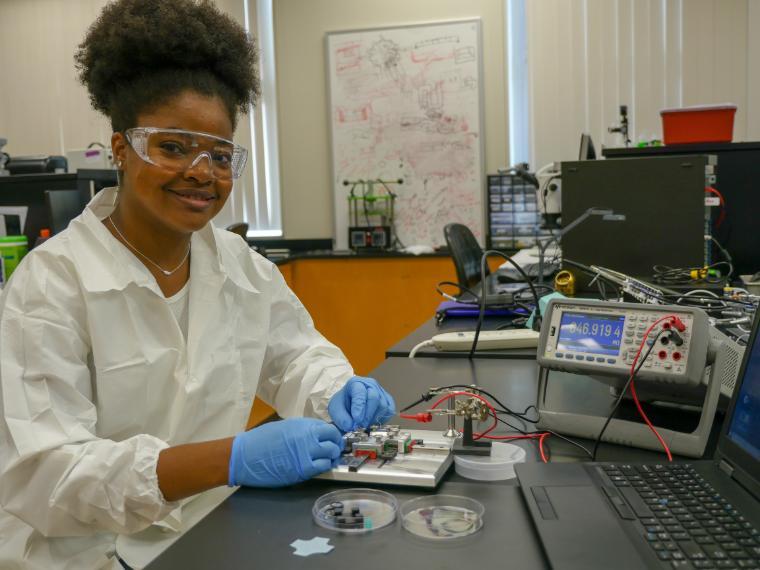
A Major Exploration
Bioengineering senior Shani Williams is focused on getting all she can out of her time at Santa Clara University, even when school is not in session. She spent the summer as part of Assistant Professor Emre Araci’s research team, developing a “wearable sensor for physical activity tracking”—an ultrathin microfluidic sensor that can be placed on the skin to measure how the tissue reacts in connection with a particular movement. Shani was paid to work on the project for 10 weeks as a De Novo Fellow—a program designed to encourage underrepresented students in engineering and the sciences to take on a research challenge.
“I wanted to explore my interest in microfluidics and work on an actual medical device. I was drawn to this major because in my view, bioengineering most closely connects products to improving people’s lives and provides a greater opportunity to create products that can help people. The device I am working on can be used for sports medicine and rehabilitation after injuries or a stroke,” she said. Dr. Araci points out the device will also be helpful in diagnosing movement disorders, such as Parkinson’s Disease. “The relationship between movement and context is an important requirement for diagnosis,” he said.
Shani began her research by running tests to measure the device’s sensitivity and directional specificity to strain. Next, she moved on to prototyping thinner and thinner devices to better conform to the skin and increase sensitivity to movement, testing on skin to see how each iteration reacts to movement.
“This research project has allowed me to become acclimated to how efficient research should be conducted to give good results. I’ve had to identify problems within the experiment; find and use the right resources; and I’ve gotten better at reading literature to help solve problems. Now I know you can’t just jump over the steps, it takes time to go through the process to get good results. Another thing I’ve really enjoyed about the experience is that it is very collaborative,” she continued. “Dr. Araci provides guidance on how to set up the experiments and the whole team of undergraduate and graduate researchers gets together every Friday to present data from our experiments and have a discussion on how to improve our work. I’ve learned a lot by listening to everyone.”
With the fall quarter starting up, Shani is picking up on some of her other activities—she’s active in the student chapter of the National Society of Black Engineers, works as a lab technician for the organic chemistry department, and is a team member and safety officer of the Women’s Rugby Club. She will also start working on her senior design project.
“I want to take advantage of as many opportunities as I can to learn about other fields of bioengineering. This summer I learned about wearable microfluidics; for senior design I will be focusing on using machine learning to make sure radiation treatments are segmented to the proper organs to reduce further cancer,” she said. Whatever she takes on, Shani gives it her all. “My grandmother has this saying she always shares," she continued, "‘If a task is once begun, never leave it till it’s done. Be the labor great or small, do it well or not at all.’ That stays with me. That’s my motto.”